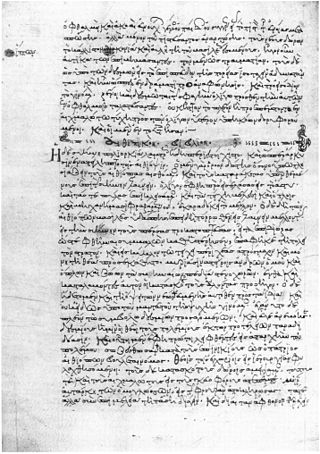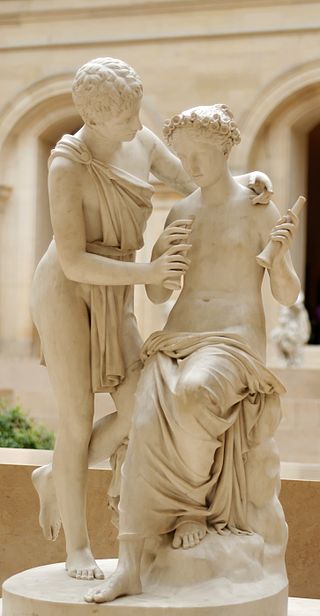Related Research Articles
Chariton of Aphrodisias was the author of an ancient Greek novel probably titled Callirhoe. However, it is regularly referred to as Chaereas and Callirhoe. Evidence of fragments of the text on papyri suggests that the novel may have been written in the mid 1st century AD, making it the oldest surviving complete ancient prose romance and the only one to make use of apparent historiographical features for background verisimilitude and structure, in conjunction with elements of Greek mythology, as Callirhoe is frequently compared to Aphrodite and Ariadne and Chaereas to numerous heroes, both implicitly and explicitly. As the fiction takes place in the past, and historical figures interact with the plot, Callirhoe may be understood as the first historical novel; it was later imitated by Xenophon of Ephesus and Heliodorus of Emesa, among others.

Heliodorus Emesenus or Heliodorus of Emesa is the author of the ancient Greek novel called the Aethiopica (Αἰθιοπικά) or Theagenes and Chariclea, which has been dated to the 220s or 370s AD.

Iamblichus was a Syrian neoplatonic philosopher of Arab origin. He determined a direction later taken by neoplatonism. Iamblichus was also the biographer of the Greek mystic, philosopher, and mathematician Pythagoras. In addition to his philosophical contributions, his Protrepticus is important for the study of the sophists because it preserved about ten pages of an otherwise-unknown sophist known as the Anonymus Iamblichi.
Iamblichus was an ancient Syrian Greek novelist. He was the author of the Babyloniaca, a romance novel in Greek. If not the earliest, it was at least one of the first productions of this kind in Greek literature.

Ancient Greek literature is literature written in the Ancient Greek language from the earliest texts until the time of the Byzantine Empire. The earliest surviving works of ancient Greek literature, dating back to the early Archaic period, are the two epic poems the Iliad and the Odyssey, set in an idealized archaic past today identified as having some relation to the Mycenaean era. These two epics, along with the Homeric Hymns and the two poems of Hesiod, Theogony and Works and Days, constituted the major foundations of the Greek literary tradition that would continue into the Classical, Hellenistic, and Roman periods.
Theano was a 6th-century BC Pythagorean philosopher. She has been called the wife or student of Pythagoras, although others see her as the wife of Brontinus. Her place of birth and the identity of her father is uncertain as well. Many Pythagorean writings were attributed to her in antiquity, including some letters and a few fragments from philosophical treatises, although these are all regarded as spurious by modern scholars.

Daphnis and Chloe is an ancient Greek novel written in the Roman Empire, the only known work of the second-century AD Greek novelist and romance writer Longus.
Julius Pollux was a Greek scholar and rhetorician from Naucratis, Ancient Egypt. Emperor Commodus appointed him a professor-chair of rhetoric in Athens at the Academy — on account of his melodious voice, according to Philostratus' Lives of the Sophists.

Byzantine romance represents a revival of the ancient Greek romance of Roman times. Works in this category were written by Byzantine Greeks of the Eastern Roman Empire during the 12th century.
Apollonius of Tyre is the hero of a short ancient novel, popular in the Middle Ages. Existing in numerous forms in many languages, all are thought to derive from an ancient Greek version now lost.

The Aethiopica or Theagenes and Chariclea is an ancient Greek novel which has been dated to the 220s or 370s AD. It was written by Heliodorus of Emesa and is his only known work.
John Myles Dillon is an Irish classicist and philosopher who was Regius Professor of Greek in Trinity College, Dublin between 1980 and 2006. Prior to that he taught at the University of California, Berkeley. He was elected a corresponding member of the Academy of Athens on 15 June 2010. Dillon's area of research lies in the history of Platonism from the Old Academy to the Renaissance, and also Early Christianity.

Literature is any collection of written work, but it is also used more narrowly for writings specifically considered to be an art form, especially prose, fiction, drama, poetry, and including both print and digital writing. In recent centuries, the definition has expanded to include oral literature, also known as orature much of which has been transcribed. Literature is a method of recording, preserving, and transmitting knowledge and entertainment, and can also have a social, psychological, spiritual, or political role.

Aesop was a Greek fabulist and storyteller credited with a number of fables now collectively known as Aesop's Fables. Although his existence remains unclear and no writings by him survive, numerous tales credited to him were gathered across the centuries and in many languages in a storytelling tradition that continues to this day. Many of the tales associated with him are characterized by anthropomorphic animal characters.

A novel is a relatively long work of narrative fiction, typically written in prose and published as a book. The English word to describe such a work derives from the Italian: novella for "new", "news", or "short story ", itself from the Latin: novella, a singular noun use of the neuter plural of novellus, diminutive of novus, meaning "new". According to Margaret Doody, the novel has "a continuous and comprehensive history of about two thousand years", with its origins in the Ancient Greek and Roman novel, Medieval Chivalric romance, and in the tradition of the Italian Renaissance novella. The ancient romance form was revived by Romanticism, in the historical romances of Walter Scott and the Gothic novel.

The Temple of Artemis or Artemision, also known as the Temple of Diana, was a Greek temple dedicated to an ancient, local form of the goddess Artemis. It was located in Ephesus. By 401 AD it had been ruined or destroyed. Only foundations and fragments of the last temple remain at the site.
The name Antiphon the Sophist is used to refer to the writer of several Sophistic treatises. He probably lived in Athens in the last two decades of the 5th century BC, but almost nothing is known of his life.

Metiochus and Parthenope is an Ancient Greek novel that, in a translation by the eleventh-century poet ‘Unṣurī, also became the Persian romance epic Vāmiq u ‘Adhrā, and the basis for a wide range of stories about the 'lover and the virgin' in medieval and modern Islamicate cultures.

Callirhoe is an Ancient Greek novel by Chariton, that exists in one somewhat unreliable manuscript from the 13th century. It was not published until the 18th century and remained dismissed until the twentieth. It nevertheless gives insight into the development of ancient prose fiction and Hellenic culture within the Roman Empire. It is one of the five largely complete Ancient Greek novels that still exist today.
References
- ↑ S.A. Stephens and J.J. Winkler, Ancient Greek Novels: The Fragments (Princeton: Princeton University Press, 1995).
- 1 2 3 Reardon, Bryan P. (1989). Collected Ancient Greek Novels. Berkeley: University of California Press. pp. 1–16. ISBN 0-520-04306-5 . Retrieved 28 May 2017.
- ↑ T. Hägg and B. Utas, The Virgin and her Lover: Fragments of an Ancient Greek Novel and a Persian Epic Poem (Leiden: Brill, 2003).
- ↑ Doody, Margaret Anne (1997). The True Story of the Novel. Rutgers University Press. ISBN 9780813524535.
- ↑ Holzberg, Niklas (2003). "The genre: novels proper and the fringe". In Schmeling, Gareth L. (ed.). The Novel in the Ancient World (Revised ed.). Boston: Brill. pp. 11–28. doi:10.1163/9789004496439_004. ISBN 978-90-04-49643-9.
- ↑ Bowie, Ewen (7 March 2016). "Novel, Greek". In Whitmarsh, Tim (ed.). Oxford Classical Dictionary . Oxford University Press. doi:10.1093/acrefore/9780199381135.013.4463.
- ↑ See in general G. Schmeling ed. The Novel in the Ancient World, 2nd ed. (Leiden: Brill, 2003) and T. Whitmarsh ed. The Cambridge Companion to the Greek and Roman Novel (Cambridge: Cambridge University Press, 2008).